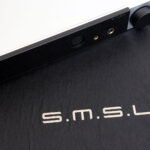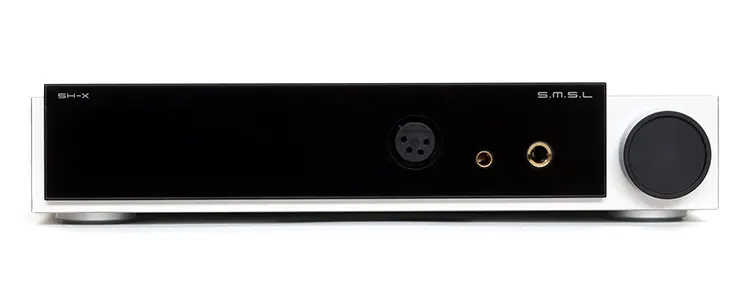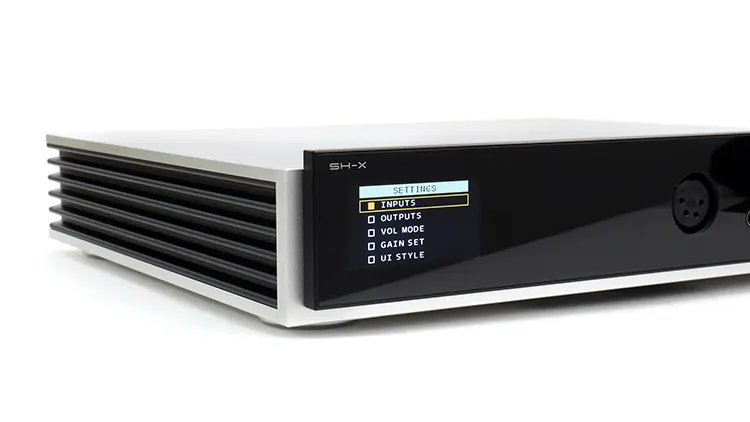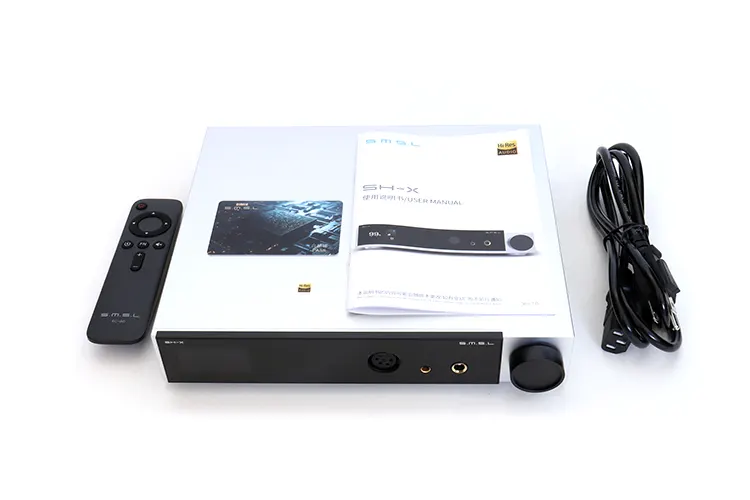Today, Louis reviews the SMSL SH-X, which is a desktop headphone amplifier and preamp capable of up to 11.5W of balanced output power. It is priced at $699.
Disclaimer: This sample was sent to me in exchange for my honest opinion. Headfonics is an independent website with no affiliate links or partnerships. I thank Shenzhen Audio and SMSL for their support.
Click here to learn more about SMSL products that we have previously featured on Headfonics.
Note, that this article follows our current scoring guidelines which you can find in more detail here.
During my recent review of SMSL SU-X standalone dual ES9039MS PRO-equipped desktop DAC, I also mentioned there would be an accompanying desktop headphone amplifier coming in for assessment.
True to my word, that amp has been here in my office for a while now going through its paces.
The unit is called the SH-X and it is a desktop-sized balanced solid-state headphone amplifier with pre-amp capability that retails for $699 via Shenzhen Audio. However, there is scant information on SMSL’s website for this unit at the time of writing.
From my perspective, this is a clean-looking design and from my testing to date, it has a strong focus on sound quality, which should be the bottom line in most amplifiers at this price point.
Features
The most intriguing part of the SMSL SH-X is that at the center core of the circuitry, lies a total count of forty carefully matched and hand-selected OP-amps per channel. That’s a total of 80 OP-amps which is a bag full.
The SH-X stacked a huge number of OP-amps to enable it to deliver up to 11.5 watts of output power per side going balanced into a 16Ω load and an equivalent 5.5 watts at 32Ω.
At 300Ω it can produce 600mW and 300mW in a 600Ω load making it more than capable of driving the likes of the ZMF Headphones Atrium or the FiiO FT3.
It’s safe to say that with this kind of power, you can drive some of the most demanding headphones out there.
However, the SH-X can also manage IEMs well and not to their destruction since the SH-X has three gain settings, the lowest of which is ideal for IEMs.
I did get a quick peek at the circuitry and for some reason, they didn’t use the large Toroidal coil setup they used on the SU-X.
Instead, they used a smaller custom transformer set and an array of large capacitors for the power section. It seems that the beefier power supply section was implemented on the SU-X.
Design
The design and overall construction aspect are identical to the SU-X DAC which uses thick Aluminum sheets for a skin that’s impervious to airborne electrical interference
The side panels are anodized black aluminum and act as a cooling finish, with a front panel slightly raised from the front bezel and cast from a thick sheet of tempered glass.
Behind the glass sits a large display that shows off all the menu’s features. I don’t understand why SMSL didn’t use matching screens on these two models since they are meant to stack together perfectly. The screens also lack color versus their previous models, like the SU-9 for example.
I recommend running these two units on separate shelves and not on top of each other directly. In that type of mounting scenario, the screens don’t matter much if they match perfectly or not.
However, the main reason you should use separate shelves is the excessive heat production, and these cabinets are not vented.
This model has a tricky protection circuitry that detects anomalies in cable impedance and internal heat.
The protection kicks in if the unit is momentarily turned off and on, you have to wait out a cooling down period before it turns back on. Perhaps that can be tweaked later on. This unit does have a rear-mounted update port.
The SH-X is one of those components that are not meant to be components you can turn on, leave on, and forget. The SH-X and the SU-X stack are meant to be used on occasion when sound quality matters.
They have no auto-standby feature which I consider they should have but it’s good to know it looks after itself and that there is a hefty protection circuitry there.
I/O
The SMSL SH-X I/O section is simple and to the point. It supplies three jacks upfront for headphones plus a dual analog input and output sections on the back panel. The rear I/O inputs are selectable while the rear outputs can be used one at a time or both simultaneously.
The front panel headphone output section consists of a single-ended 6.35mm full-size jack, a 4.4 Pentaconn, and a 4-pin XLR balanced hookup. The use of a common 6.35mm step-down adapter to a 3.5mm takes the total from three to four headphone connectivity options.
There are two sets for each of the input and output sections on the rear panel. The two sets consist of dual RCA connections plus dual 3-pin XLR connections.
The SH-X does have a USB-C connection but it’s not a digital input. It’s labeled update so who knows if in the future this unit will pick up some added features via some kind of firmware update. So, it seems there are upgrade possibilities.
Controls
The SMSL SH-X has a single multifunction volume control upfront that allows you to adjust the volume as well as access the front panel menu screen and scroll and select features within the menu.
The volume knob is indented and seems to employ a relay-switching attenuator volume control type of implementation. A press and hold of the volume knob allow the user to put the unit on standby and wake the unit and a momentary push activates the menu.
The menu system will allow you to select the volume control action to function in real-time or soft ramp-up mode. The volume has one hundred steps of adjustment from 0 to 99 giving the user a good amount of finite control over the volume levels.
The rear panel houses the other two controls for this model consisting of a large rocker switch that acts as the main power switch and a switch to operate the unit in grounded or floating ground mode.
Remote Control
The remote control allows the user access to all of the SH-X features. The remote control has volume adjustment and a mute feature with an input selector plus you can access the main menu.
The remote uses two AAA batteries which are easy to install but SMSL does not include a set inside the box. Shipping electronics with batteries can get tricky nowadays so I understand why SMSL does not include batteries.
The remote control looks identical to the one supplied with the SU-X so if you have the stack, you will have to mark one of them to distinguish one from the other. They are that similar and I wished there was a way of combining the two into one universal remote rather than separate.
Menu
The SMSL SH-X glass-bonded IPS display has a features menu that can be accessed by a short tap on the volume knob or from the remote. You will feel a distinct click when you press the volume knob and it gives off a distinct feel of assured engagement.
The first two features on the menu list are labeled inputs and outputs. Within those two menus, you can choose what input port you want to tap into and how many of the outputs you want to run. Then there is a volume mode that lets you select between soft and real-time.
Below is a 3-level gain selector, a UI style selector and you get to choose from two distinct styles, universal or graphics. Then comes a dimmer feature, a brightness adjustment, and a reset feature.
SMSL should have implemented the SUB-X’s sound features such as standard, tube, rich, etc, on the SH-X amp instead.
It would have made more sense to implement a sound tuning feature on the amplifier labeled as such and not on the DAC section. I say that because there seems to be no sound tailoring capability within the menu of the SH-X.
Packaging & Accessories
The SH-X comes in a large black box made from paper pulp with a silver company logo graphic, and all of the innards are seated inside a custom foam mold of medium density.
Inside, you will find the remote control but there are no batteries included as stated. You will need a set of AAA batteries to get the remote control going. You will also find a thick 3-prong grounded power cord, an SMSL pass card, and a user’s manual.
Sound Impressions
For the following sound impressions of the SH-X, the three gain settings remained on the low and mid-gain settings most times because the high gain setting is reserved for the hardest-to-drive and most demanding headphones.
The SU-X was used to feed the SH-X using dual XLR cables. I also used the new Topping D90 III Sabre for a different ES9039 DAC perspective. Also, the SH-X was fed with HIFIMAN’s HYMALYA 2 DAC via the EF600 and the iFi Audio NEO iDSD 2 DAC section.
All the internal sound features of the SU-X and other DAC sections were turned off and the digital filter section was set to filter off to keep things as neutral as possible.
Headphones included the HIFIMAN Sundara, Arya Organic, and the Dekoni Audio Blue.
Tonal Coloration
The SMSL SH-X seems fluent in obtaining extension in both directions of the frequency spectrum, more so in the higher frequencies but seems a smudge more vocal-focused over anything else but close to neutral.
There seems to be an added chant factor over past SMSL iterations and music production seems natural and enhanced due to a higher signal-to-noise ratio that produces a punchy, dynamic. And fast-acting attack and decay.
The bass response has speed and body while the forward-sounding midrange brings forth lots of nuanced detail. Detail production seems to be one of the best traits here. The treble response is extended, crystalline, and free from hiss, artificiality, and full of top-end sparkle.
The SMSL SH-X is certainly a powerhouse of an amp that can drive the most demanding headphones and it can produce a hard-hitting bottom end that never runs out of driving power.
The midrange seems a couple of decibels augmented in the upper range mostly, but the overall signature is well-balanced.
Staging & Dynamics
One of the SH-X’s best characteristics is the ability to retain staging information intact and with the right DAC, this amplifier can produce a prominent level of pinpoint accuracy as far as proper placement.
This amplifier retains a good amount of depth and can produce sound technically capable of placing a note anywhere between the listener and the frontal space it occupies along with accurate lateral placement.
The SMSL SH-X is also a formidable performer when it comes to dynamic range and hits a high impactfulness level alongside a soundstage that is large and powerful. But it can also sound soft-mannered and delicate.
All those OP-amps produce a full spectrum that is a bit aggressive and forward but due to the dark background it allows for a lot of detail to come forth, ample spatial information, and a highly enjoyable brunt presentation.
Click on page 2 below for my recommended pairings and selected comparisons.








